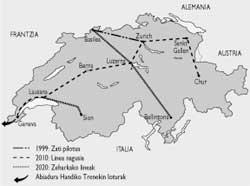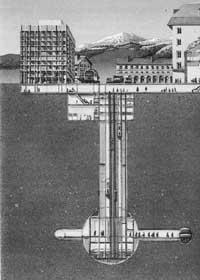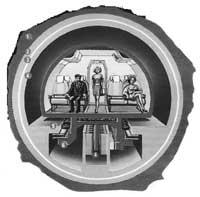Metro for all Switzerland
Currently, the number of travelers in Switzerland is three times higher than in 1950 and more than 80% move on the roads. It must be remembered, however, that thirty years ago that percentage corresponded to the railroad.
However, every day there are more travelers and the roads are full. In addition, car pollution and obstruction of traffic cause great expenses to the Swiss Confederation.

A solution is to improve the rail network, but according to experts this is not so simple. There are four main obstacles to this. On the one hand, there are more and more urbanized areas, but it must be taken into account that the territories of Switzerland are abrupt. On the other hand, it should not be forgotten that environmental protection measures are increasingly stringent and that the expropriation of land is becoming more and more difficult.
According to Professor Francis-Luc Perret of the Polytechnic School of Lausanne, the Swiss metro, known as “Swissmetro”, would overcome all these obstacles. The project, designed in 1974 by engineer Rodolph Nieth, consists basically of a network of meters that would reach a speed of 500 km/h in the Swiss subsoil. All of Switzerland would be a city of 300 kilometers in length. The main current cities would be the metro station and you could go from Geneva to Bernardo for twenty-seven minutes. It is estimated that the average duration of the journey between stations will be twelve minutes, for which the underground train would reach speeds of 400 and 500 km/h.
Magnetic levitation trains
The train that would circulate at these speeds would go by magnetic levitation 20 millimeters above the track and in the tunnels the air would be eliminated and a vacuum would occur to some extent. In recent times, important tests have been carried out on magnetic levitation trains in Germany and Japan. The German train, known as “Transrapid” or “Magnetbahn”, has reached an approximate speed of 450 km/h on the road to Emsland. This 122-ton heavy train would displace approximately 200 passengers. The Japanese prototype MLU002 has reached a speed of 517 kilometers per hour on its way to Miyazaki. However, both the Germans and the Japanese have financial difficulties. The Osaka to Tokyo railway construction project, for example, is paralyzed.
All these projects must overcome the air resistance at these speeds. Therefore, the solution designed for the Swiss metro is to remove this air from the tunnels.
According to a triennial study at the Lausanne Polytechnic School, the project can be done technically, improve the Swiss transport system and would be economically profitable.
What kind of tunnels?
The geological situation of the Swiss subsoil is well known. In fact, to date, numerous tunnels and galleries have been opened in the works carried out. On highways, railways and other works such as the CERN Geneva's underground fractions accelerator, tunnels of similar diameter have already been built. For this “swissmetro” it is intended to perform two parallel tunnels in each line, one for each direction, at a distance of approximately 25 meters between the two.


Each tunnel would have an outer diameter of 5 meters and an inner diameter of 3.6 meters (approximately half of the most classic train) and would be drilled at a depth of 40 to 100 meters. If a tunnel had to be closed between two stations, the traffic would circulate through the parallel tunnel. In the stations there would be a passage from a tunnel to its parallel or a metallic structure in three zones to move from a tunnel to its parallel and from one metro line to another.
In addition to the two parallel tunnels of the trains, there would be a third gallery for the passage of cables or departure of passengers in case of accident, which is expected to have air within five seconds.
Taking air out of the tunnels becomes empty to a certain extent. There is no other remedy for the train to reach a speed of 400-500 kilometers per hour in these small tunnels. In a tunnel with a section of 20% higher than the vehicle, when the train travels 400 kilometers per hour (0.3 Mach) it is blocked. The air accumulates in front of the vehicle, braking it.
The solution is to lower air pressure inside the tunnel. This pressure can vary between 0.1 and 0.01 atmospheres by installing flow pumps of 20,000 m3/h. Therefore, in the tunnel there would be atmospheric conditions of altitudes between 20.000 and 42.000 meters.
Propulsion and suspension of the train
The reduction by simple air resistance will reduce the energy necessary for the propulsion of the train and reduce the operating costs. It is estimated that the Swissmetro train will consume three times less energy than the conventional electric train.
The propulsion would be made by fixed linear motors in the tunnel that would be fed from the high voltage network. When the train is braking, the engines will become dynamo and thanks to the braking power will generate electric current. In this way, about 80% of kinetic energy will be recovered in deceleration.
The train will be 20 millimeters above the ground thanks to the magnetic suspension. The magnetic levitation has three advantages: at very high speed the train is easily driven, the rails do not wear out and the noise is very small.
In case of failure in the propulsion system would not affect the suspension, since the sources of elika are independent. However, in the worst case, the train would be mechanically postponed with friction on its skates. In this case, through an autonomous motor, the train would travel to the adjoining stop or emergency exit.
Due to vacuum tunnels to a certain extent, engineers have designed train cars and pressurized stations. Trains 200 meters long will pressurize like planes. For the access and departure of 800 passengers to the train, there will be a lock that will cover the entire train in the station.
What stations?

The swissmetro stations will have a special difficulty. They must have an atmospheric pressure in which passengers cannot circulate in vacuum without air. The vacuum zones will, therefore, be separated from the stops.
The swissmetro stations would be located under the stations of the federal railways, CFF or Switzerland, with two slopes. On the one hand would be the surface room where connections with other public transport would be made. On the other hand, the underground dock of entrance and exit to the train. Joining these two aspects would circulate eight two-story elevators, with capacity for 100 people each.
The depth of these wells and tunnels will depend on the geological situation of the site.
Costs and financing
The cost of this metro for all of Switzerland will be high. The current estimated cost is more than 28,000 million Swiss francs, three of which correspond to underground infrastructure. However, the designers are hopeful and say it will be profitable. The Geneva-Sankt Gallen line, for example, expects an income of CHF 500 million in 2004.
It is also more reason for the metro. Besides the station, every kilometer of the line will need 32 million Swiss francs, and the cost of one kilometer of motorway in Switzerland is higher. In addition, the Swiss say the train trend is immediate and expect to transport four billion passengers/kilometer by 2010. Consequently, the Swissmetro will not need a grant.
However, this Swissmetro project still has some points to deal with. In case of failure or accident, the air must enter immediately into the tunnel and the 800 passengers of the train will not be easy to extract quickly, especially if it is a sabotage in the tunnel or in the train.
But this type of train has its advantages. On the one hand, there would be no fear of leaving the lanes and on the other, there would be no fear of fire, because there would be no air.
Buletina
Bidali zure helbide elektronikoa eta jaso asteroko buletina zure sarrera-ontzian











